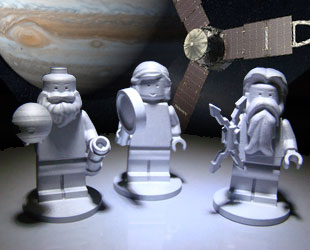-

PASADENA, Calif. - Earlier today, navigators and mission controllers for NASA's Juno mission to Jupiter watched their computer screens as their spacecraft successfully performed its first deep-space maneuver. This first firing of Juno's main engine is one of two planned to refine the spacecraft's trajectory, setting the stage for a gravity assist from a flyby of Earth on Oct 9, 2013. Juno will arrive at Jupiter on July 4, 2016.
The deep-space maneuver began at 6:57 p.m. EDT (3:57 p.m. PDT) today, when the Leros-1b main engine was fired for 29 minutes 39 seconds. Based on telemetry, the Juno project team believes the burn was accurate, changing the spacecraft's velocity by about 770 mph (344 meters a second) while consuming about 829 pounds (376 kilograms) of fuel.
"This first and successful main engine burn is the payoff for a lot of hard work and planning by the operations team," said Juno Project Manager Rick Nybakken of NASA's Jet Propulsion Laboratory in Pasadena, Calif. "We started detailed preparations for this maneuver earlier this year, and over the last five months we've been characterizing and configuring the spacecraft, primarily in the propulsion and thermal systems. Over the last two weeks, we have carried out planned events almost every day, including heating tanks, configuring subsystems, uplinking new sequences, turning off the instruments and increasing the spacecraft's spin rate. There is a lot that goes into a main engine burn."
The burn occurred when Juno was more than 300 million miles (483 million kilometers) away from Earth.
A second deep space maneuver, of comparable duration and velocity change, is planned for Sept. 4. Together, they will place Juno on course for its Earth flyby, which will occur as the spacecraft is completing one elliptical orbit around the sun. The Earth flyby will boost Juno's velocity by 16,330 mph (about 7.3 kilometers per second), placing the spacecraft on its final flight path for Jupiter. The closest approach to Earth, on Oct. 9, 2013, will occur when Juno is at an altitude of about 310 miles (500 kilometers).
"We still have the Earth flyby and another 1.4 billion miles and four years to go to get to Jupiter," said Scott Bolton, Juno's principal investigator from the Southwest Research Institute in San Antonio. "The team will be busy during that whole time, collecting science on the way out to Jupiter and getting ready for our prime mission at Jupiter, which is focused on learning the history of how our solar system was formed. We need to go to Jupiter to learn our history because Jupiter is the largest of the planets, and it formed by grabbing most of the material left over from the sun's formation. Earth and the other planets are really made from the leftovers of the leftovers, so if we want to learn about the history of the elements that made Earth and life, we need to first understand what happened when Jupiter formed."
Juno was launched on Aug. 5, 2011. Once in orbit, the spacecraft will circle Jupiter 33 times, from pole-to-pole, and use its collection of eight science instruments to probe beneath the gas giant's obscuring cloud cover. Juno's science team will learn about Jupiter's origins, structure, atmosphere and magnetosphere, and look for a potential solid planetary core.
Juno's name comes from Greek and Roman mythology. The god Jupiter drew a veil of clouds around himself to hide his mischief, and his wife, the goddess Juno, was able to peer through the clouds and reveal Jupiter's true nature.
NASA's Jet Propulsion Laboratory, Pasadena, Calif., manages the Juno mission for the principal investigator, Scott Bolton, of Southwest Research Institute in San Antonio. The Juno mission is part of the New Frontiers Program managed at NASA's Marshall Space Flight Center in Huntsville, Ala. Lockheed Martin Space Systems, Denver, built the spacecraft. JPL is a division of the California Institute of Technology in Pasadena.
Quelle: NASA
Blick auf die "dänischen Passagiere" der Juno-Sonde:

